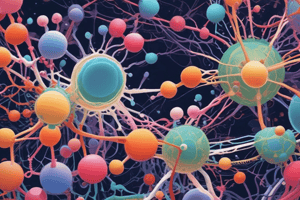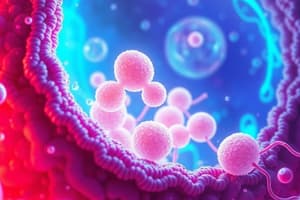Podcast
Questions and Answers
What is the primary role of nonenzymatic glycosylation in relation to polypeptides?
What is the primary role of nonenzymatic glycosylation in relation to polypeptides?
- It synthesizes sugars for energy production.
- It cleaves polypeptides into amino acids.
- It creates glycoproteins through the chemical addition of sugars. (correct)
- It removes sugars from polypeptides.
Which statement about pepsin's optimum pH is correct?
Which statement about pepsin's optimum pH is correct?
- Pepsin functions best at a neutral pH of 7.1.
- Pepsin's activity is optimized at an acidic pH of 2. (correct)
- Pepsin requires an alkaline environment, with an optimum pH of 8.1.
- Pepsin remains inactive at both acidic and neutral pH levels.
Which enzyme action is characteristic of a proteolytic enzyme?
Which enzyme action is characteristic of a proteolytic enzyme?
- It forms glycoproteins by joining proteins to sugars.
- It converts starches into simple sugars.
- It cleaves protein molecules into smaller units. (correct)
- It assembles fatty acids into protein chains.
What distinguishes anabolic enzymes from catabolic enzymes?
What distinguishes anabolic enzymes from catabolic enzymes?
What is the primary determinant of a protein's function?
What is the primary determinant of a protein's function?
Which of the following correctly identifies what is not produced by or an intermediate of the Citric Acid Cycle?
Which of the following correctly identifies what is not produced by or an intermediate of the Citric Acid Cycle?
Which process synthesizes ATP from ADP?
Which process synthesizes ATP from ADP?
What is a primary function of the Citric Acid Cycle?
What is a primary function of the Citric Acid Cycle?
Which of the following identifies a characteristic of omega-3 fatty acids?
Which of the following identifies a characteristic of omega-3 fatty acids?
Fatty acids are esterified into mono-, di-, or triglycerides by binding to which molecule?
Fatty acids are esterified into mono-, di-, or triglycerides by binding to which molecule?
Study Notes
Glycosylation and Enzymatic Functions
- Nonenzymatic glycosylation, or glycation, refers to the chemical addition of sugars to polypeptides, resulting in the formation of glycoproteins.
- Catabolic enzymes function by cleaving a molecule into two or more parts, facilitating breakdown processes in metabolism.
- Anabolic enzymes join two or more substances into larger molecules, contributing to biosynthesis and growth.
- Allosteric enzymes can act as either catabolic or anabolic enzymes and require specific cofactors for activation.
Sugar Types and Properties
- Ribose is a 5-carbon sugar, while glucose and fructose are 6-carbon sugars, and sucrose is a disaccharide.
- The optimum pH for pepsin, a digestive enzyme, is 2, indicating its effectiveness in the acidic environment of the stomach.
Proteolytic and Amylase Functions
- Proteolytic enzymes cleave protein molecules into smaller units, essential for protein digestion.
- Amylase catalyzes the breakdown of starches into sugars and is present in human saliva. It does not cleave proteins into amino acids.
Protein Structure and Synthesis
- The function of proteins is significantly influenced by their spatial conformation, not merely by their molecular weight or amino acid count.
- Amino acids in proteins are joined by peptide bonds, forming long chains essential for protein structure.
- The biosynthesis of proteins involves codons, ribosomes, and messenger RNA; amylase is not a participant in this process.
Citric Acid Cycle and Energy Production
- The primary function of the Citric Acid Cycle is to facilitate aerobic cellular energy production through the oxidation of organic substrates.
- Reduced intermediates produced in the Citric Acid Cycle supply electrons for converting ADP into ATP via phosphorylation.
- NADH, citrate, and water are produced through the Citric Acid Cycle, but glucose is not an intermediate or product.
ATP and Fatty Acids
- ATP serves as a cellular energy transfer medium and is formed from ADP through dehydration synthesis and oxidative phosphorylation.
- Eicosapentaenoic acid is a free fatty acid, while triglycerides result from attaching fatty acids to glycerol.
- Omega-3 fatty acids are characterized by having at least 3 double bonds and a double bond located 3 carbons from the end of the carbon chain.
Studying That Suits You
Use AI to generate personalized quizzes and flashcards to suit your learning preferences.
Description
Test your knowledge on key concepts in biochemistry, including nonenzymatic glycosylation, sugar types, pepsin pH, and enzyme functions. This quiz covers fundamental topics essential for understanding biochemical processes.




